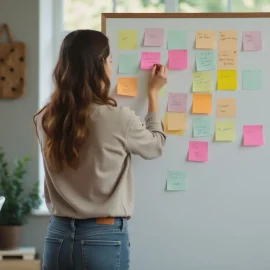

This article is an excerpt from the Shortform book guide to "Someday Is Today" by Matthew Dicks. Shortform has the world's best summaries and analyses of books you should be reading.
Like this article? Sign up for a free trial here.
Do you have big dreams but continually fail to make much progress? How many moments have you squandered just today?
In Someday Is Today, Matthew Dicks explains how you can eliminate time-wasters and increase your efficiency on necessary tasks. Then he argues that you must learn how to maximize productivity and reach your full potential so you can become as successful as possible, as soon as possible.
Continue reading for Dicks’s top six principles for maximizing productivity and an exercise to help you apply them.
#1: Use Every Spare Moment to Do Something Productive
Dicks’s first piece of advice on how to maximize productivity is to use every spare moment to make progress toward your goals. He explains that most people struggle to make progress because they feel like they don’t have time to be productive, or they’re waiting for the right conditions—for example, a quiet space, an hour’s time block, the “right” hour of the day, and so on. However, these are just excuses to delay taking action. You don’t need perfect conditions to get started: All you need is a few minutes of free time.
For example, if you’re waiting for your professor to start her lesson, pull out your notebook and start brainstorming your next creative project—even if you only have a few minutes, you’ll be a few minutes closer to reaching your goal.
(Shortform note: Using every spare moment to do something productive might be counterproductive because it leaves no time for breaks. In Hyperfocus, Chris Bailey explains that rest—not just sleep, but restful breaks throughout the day—is essential to productivity because it increases your working memory capacity and your ability to focus on and perform tasks effectively. Consequently, Bailey recommends taking a 15-minute break every 90 minutes or so. During this time, don’t perform any tasks (even menial ones like scrolling on social media)—just let your brain wander.)
#2: Don’t Put All Your Eggs in One Basket
Second, avoid putting all your eggs in one basket, Dicks suggests. He explains that people who dedicate themselves solely to one goal, discipline, or area of interest won’t reach their full potential and achieve extraordinary things. They’re blind to additional areas in which they might thrive because they’ve never considered pursuing them.
To overcome this self-limiting behavior, Dicks offers two tips:
- Take every opportunity. Dicks argues that you should take every opportunity you’re presented with, even if it doesn’t necessarily contribute to your current goal.
- Branch out. Pursue multiple goals, disciplines, or areas of interest at the same time, Dicks notes. This is important for two main reasons:
- You’ll solve problems and remain productive in the meantime.
- You’ll increase your creativity.
#3: Fail Often
Next, Dicks recommends pushing yourself and failing often. He argues that, to progress, you must fail first—the more you fail, the closer you’ll get to success. Failing makes you realize what you’re doing wrong, and every attempt from that point on will be better as you correct your mistakes.
| Analyze Your Failures Using the ‘Five Whys’ Technique Some experts agree that pushing yourself and learning from your failures is crucial to reaching your goals. They add to Dicks’s argument by specifying how exactly you can use your failures to your advantage: Objectively analyze your failures to determine what went wrong. You could use the ‘Five Whys’ technique: First, ask yourself why things didn’t go as planned at the most surface level. Then, ask yourself why your answer was the case. Finally, repeat the process three more times until you’ve asked “why” a total of five times. You’ll uncover the fundamental reason for your failure so you can learn from and avoid it in the future. For example, imagine you failed to get a graphic design job you applied for. Your five whys would be (1) Why did I fail to get the job? Because my style didn’t match the company’s needs. (2) Why didn’t my style match? Likely because my designs are fairly simple compared to the intricate designs featured on their website. (3) Why are my designs too simple? Probably because I’m used to designing for local businesses rather than big corporations. (4) Why do I always design for local companies? Because I tend to apply for smaller jobs that I feel confident I’ll receive. (5) Why do I only apply for these types of jobs? Because I fear rejection. Ultimately, your fear of rejection led to your failure in this situation because it prevented you from pushing yourself outside your comfort zone and adapting your graphic design style. |
#4: Motivate and Inspire Yourself
Dicks also advocates learning how to motivate and inspire yourself. He believes this is crucial to implementing his previous recommendation to fail often—you’ll only be resilient and persistent enough to learn from your disappointing failures and keep pursuing success if you can motivate yourself. Further, aside from failure, you’ll encounter many obstacles on the path to success that require motivation to overcome—disrupted plans, rejections, and more.
Dicks offers three tips for building internal motivation and inspiration:
- Find your why. Remembering the underlying reasons why you’re pursuing your goals will inspire and motivate you to continue.
- Reflect on your struggles and successes. Dicks notes that it’s easy to get worn down and feel like giving up when you face barriers or fail to see results from your work. To persist through these challenges, remind yourself of all the hardships you’ve faced in the past and how you overcame them.
- Celebrate your achievements. Celebrate your achievements, big and small, as you progress toward your goals, Dicks suggests.
#5: Maximize Your Creative Potential
Dicks also recommends boosting your creativity by implementing the following tips:
- Consume varied content. Consume a wide variety of content as often as you can, Dicks suggests. You’ll expand your knowledge in new directions and come up with new, unique ideas.
- Reuse your old work. Dicks recommends making the most of the work you’ve already created by reusing it for future projects. You can do this in three ways:
- Repurpose a project that didn’t work out for a different, future venture.
- Use components of past projects for future projects.
- Use past projects to inspire your work on future projects.
#6: Create a Support Group
Finally, Dicks recommends finding a group of people to support you. They’ll help you progress toward your goals by holding you accountable and providing encouragement and feedback.
To create your support group, choose the people who love and support you—avoid people who might envy your success, as they might undermine you. Further, share your work, goals, and deadlines with these people so they can give you constructive feedback and hold you accountable for completing goals.
Exercise: Create More Time for Productivity
Dicks recommends boosting your chances of success by using every spare moment to do something productive. But to have more spare time, you must maximize your time and efficiency. In this exercise, we’ll identify the time-wasters that you can eliminate and tasks that you can complete efficiently to create more spare time for working toward your goals.
- Record five to 10 routine tasks that you perform daily and the amount of time you spend completing each one: for example, scrolling on your phone before getting out of bed—10 minutes, making breakfast—15 minutes, reading your email—10 minutes, and so on.
- Identify whether each task you listed is necessary. Cross the unnecessary tasks off your task list and stop doing them. For the necessary tasks, estimate the minimum amount of time you can complete them in and make this your new goal. (For example, scrolling on your phone is unnecessary, so stop doing it; making breakfast is necessary, but you can probably get it done in five minutes rather than 15.)
- Now that you’ve eliminated unnecessary tasks and minimized the time allotted to complete necessary ones, consider whether you can combine any tasks (multitask) to get things done faster. (For example, rather than taking five minutes to eat breakfast and five minutes to check your email, combine these tasks and check your email while you eat breakfast.)
- At this point, you’ve gotten rid of unnecessary tasks, minimized time spent on necessary tasks, and identified areas where you can multitask. Record how much time you’ve now saved and how you’ll use that extra time to make progress toward your goals. (For example, if you’ve gotten rid of three unnecessary tasks that typically take 10 minutes each, reduced two 10-minute tasks to 5 minutes, and then combined those two tasks, you’ve saved 45 minutes each morning. You can now use this time to send in audition tapes to progress toward your goal of being an actor.)

———End of Preview———
Like what you just read? Read the rest of the world's best book summary and analysis of Matthew Dicks's "Someday Is Today" at Shortform.
Here's what you'll find in our full Someday Is Today summary:
- Why most people delay taking action toward their dreams and goals
- Tips for accomplishing extraordinary things in life
- How to maximize your time, efficiency, productivity, and creative potential






